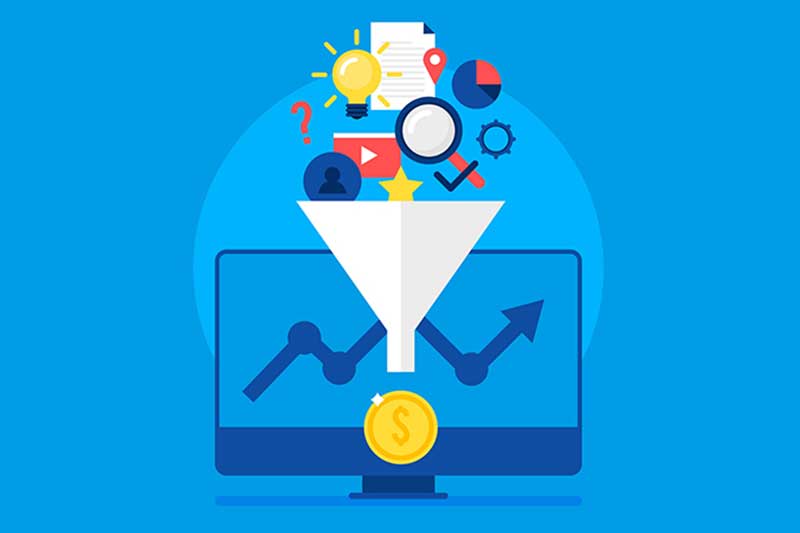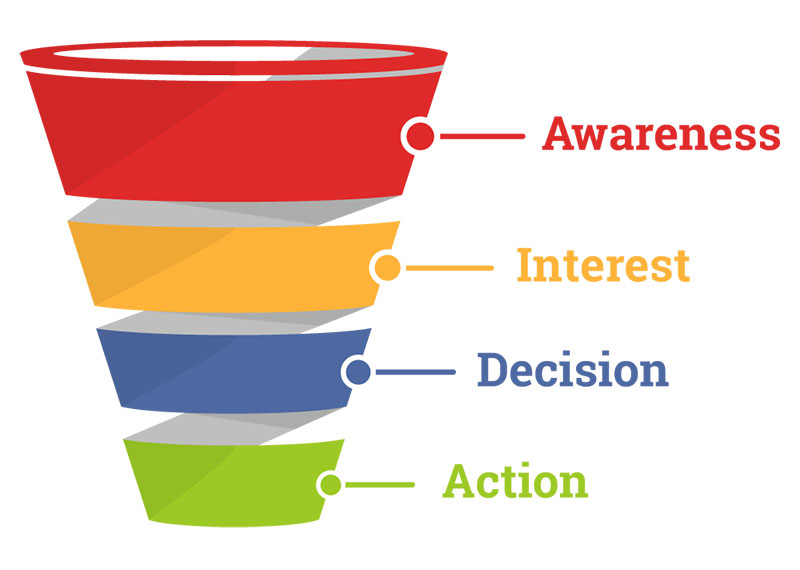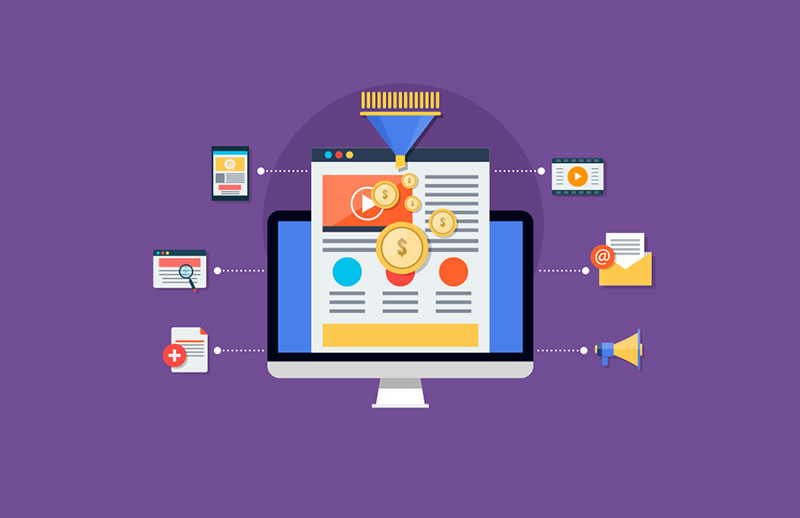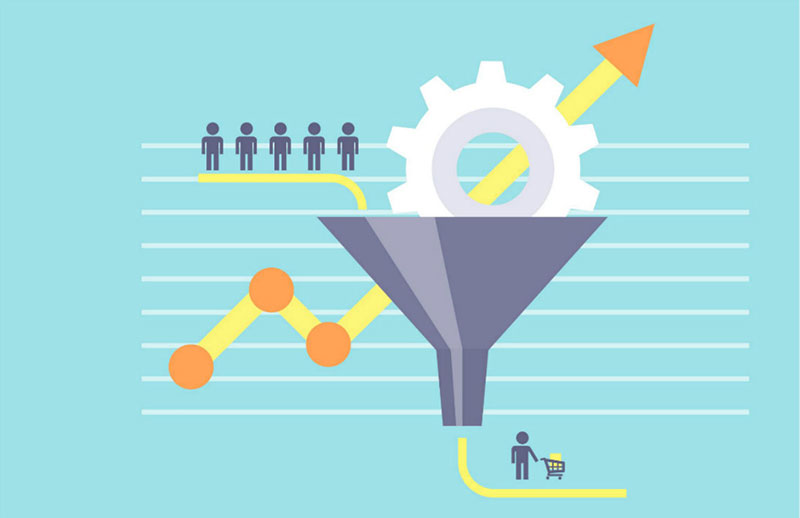Sales funnel: what is and how to create one for your business
One of the fundamental concepts of digital marketing is the sales funnel.
Although it may sound strange, this strategic model is so effective that many professionals built careers on implementing this unique concept in the business world.

What is a Sales Funnel
A sales funnel is the visual representation of the customer journey, describing from the first contact with the brand to the purchasing decision.
Ryan Deiss, co-founder of Digital Marketer, often describes the sales funnel as a multi-step, multi-modality process that moves prospective browsers into buyers.
This process consists of a set of steps and triggers whose purpose is to guide and support the buying journey.
– Tips to create a Customer Journey Map
The stages of the sales funnel are directly connected to the three phases of the buying journey, which are
- Tofu – top of the funnel: stage where the client discovers that he has a need / problem and makes the first contact with your company. What to do: offer free relevant content by form-filling. When entering his data, the user becomes a lead and advance the sales funnel.
- Mofu – middle of the funnel: stage in which the company must help the customer solve their problem. What to do: provide specific content, such as technical tips, guides or even an app. Qualify the lead so that it take another step in the funnel.
- Bofu – bottom of the funnel: step that should lead to the purchase decision. What to do: the leads are ready to be approach by the sales team. With the trust already built in the previous steps, show that you have the best solution to what they seek.
The sales funnel closes when prospects make their purchase and become customers.
This entire process may seem long and time consuming, but the truth is that most of your prospects will not buy on the first visit to your site, especially if they have just discovered that your business exists.
For this reason, the sales funnel is considered a multi-mode process, as there are a variety of relationship building experiences that occur through several stages.
Understand how the sales funnel works

As explained earlier, the sales funnel is responsible for supporting the personas through the buying journey.
Buyer persona is a semi fictional representation of your ideal customer based on market research and actual data of your current customers.
– What is it and how to create a buyer persona
A persona is, as the name suggests, a character created to help your company better understand who the customer is and what he needs.
Buying journey consists of four steps: awareness, interest, decision, action.
Its goal is to represent the steps the customer goes through to the moment of decision-making and purchase.
Understand the buying journey is fundamental to understanding the concept of sales funnel, so let’s address its steps in more detail.
- Awareness: motivated by a question or problem, the customer do a search by keyword related to your business and find your site for the first time, becoming aware of your company, solution, product or service.
- Interest: the customer acknowledges that he has a problem/need and begin to actively search for solutions. This is the moment he expressed real interest in your product/service, interacting with your content, website and communication channels.
- Decision: at this stage the consumer looks carefully to what your company has to offer, including different packages and options, so he can make the final decision.
- Action: stage where the lead performs an action, such as signing a contract or click the buy button. This is the moment he becomes a client.
Note that, depending on each business, there may be additional steps in the sales funnel.
A major advantage of a strategic model that values the relationship with the consumer, is that your customers might become brand advocates and bring more business that way.
At the same time, they might buy again from you and become loyal customers.
How to use content for each stage of the sales funnel

One of the biggest mistakes a company can make is not align their content marketing efforts with its stages of the sales funnel.
Not offer the wrong content can mean the loss of attention of the prospect and its stagnation in the buying journey.
Not avoy this error, see what types of content you can use for each stage of your sales funnel.
ToFu
The top of the funnel content should focus on making your audience realize they have a problem to be solved.
At this stage, you can offer:
- Blog posts: writing on topics related to your product/service is a good way to improve your organic search and make the customer find you. Quality content proves that you are an authority on the subject and attracts qualified audience.
- Infographics: simple and visual way to pass information in a clear and direct manner, facilitating user understanding.
- Podcasts: for lazy readers, podcasts are a great alternative to acquire more knowledge on a particular subject. In addition, they increase the time user spent on your website.
- Newsletter: periodic publication sent by the company to its customers and potential customers. Direct communication with the consumer, it has a very high potential for conversion and loyalty.
- Social networks: popular media, work your networks in an integrated way and use images, gifs and other resources to draw the attention of users.
Your content in this phase should be easy to access and understand, arousing the visitor’s curiosity for it to become a lead.
MoFu
Time to offer even more informative content, focused on providing solutions without talking about sales.
At this stage of the sales funnel, try to capture as much information as possible about the customer, to provide even more qualified material.
By offering rich materials, for example, you can ask the user to fill out a form to access or download content.
The most commonly used materials in this phase are:
- Blog posts: it continue, but it should be more specific. Create content with data and information about a particular problem and how to solve it.
- Ebooks: the famous digital book is a good way to approach a subject in more detail, and the text would be very extensive for a blog post.
- Checklists: a checklist is a simple step by step list on how to perform certain activity. It works as a manual to guide the reader on every stage of execution of a task.
Remember that this stage starts a closer relationship with the lead, and the content should clarify all his doubts.
BoFu
Now is the time to make it clear why your company is the best option of the market to solve the customer’s problem.
Your content should focus on the sale and guide the buying decision. For this you can use:
- Webinar: the webinar is a live streaming seminar that allows you to explain more about your solution, make use of demonstrations and interact with the audience.
- YouTube videos: YouTube is the second largest search engine today and a great way to provide explanatory videos focusing on sales to millions of people at once.
- Success cases: testimonials from customers who have already purchased your product or service commenting on its advantages and results obtained. A third-party evaluation has great weight to a new buyer.
– How to sell courses with YouTube
Note that the options for the different stages of the funnel are numerous. All you need is a good planning and content developer.
Creating a sales funnel

Is very important to have well defined stages of the sales funnel, because only then the manager can have a vision of the whole, identify where failures occur and plan improvement actions.
Therefore, to assist in creating your sales funnel, we’ve prepared a simple guide.
1 – Know your customer
To start, you need to collect information about your customers to understand what they want and need.
Thus, you will understand their needs, frustrations and how well (or not) your solution helps solve the problem of your target audience.
This way, you can modify your funnel to focus on the main points raised, in addition to obtaining relevant insights to adjust your product or service and make it better.
The most important questions you can ask your customers are:
- What are your current challenges (related to your product/service)?
- What are your fears and frustrations? What are your goals and aspirations?
- What have you done to try to solve your problems/achieving your goals? Works well?
Based on the data collected you can define your buyer persona.
2 – Build your buyer personas
The truth is that you can not have the same sales funnel for all your customers. This is mainly because:
- They have different reasons to buy your product;
- They will use it differently;
- They make buying decisions in different ways.
It is much smarter to create different personas and create different funnels to better suit your needs.
3 – Traffic and Lead Generation
There are three different methods you can use to generate traffic to your website and get leads: paid ads, organic search or direct approach.
Paid ads are the easiest and quickest way to bring visitors to your site. You pay to display an ad and each person who clicks on it is directed to your page.
– Understand what it is and how the Remarketing works
For this you can use:
- Google AdWords
- Ads on social networks (Facebook, Instagram, LinkedIn)
The disadvantage of this strategy is that once you stop paying, the movement on your website ceases.
Affiliate marketing also is a form of paid traffic. The only difference is that you do not pay in advance, only after a sale has been made.
To get organic traffic you don’t pay directly to search engines and other online channels. However, this does not mean that is truly free.
– How to reduce costs with Google Ads
Is necessary to invest time and effort to optimize your website for Google and gain relevance in searches.
This strategy focus in:
- SEO
- Posts on social networks
- Link building
The direct approach it is the most time-consuming strategy among the tree.
Involves you sending cold emails or cold calling companies that might need your product or services.
4 – Milestones definition
To track client progress in the sales funnel, you need to know exactly when it passes from one phase to another.
So, when defining what are the stages of your funnel also determine what are the milestones that will signal when the customer advance a stage.
Set these milestones is necessary to generate a standardization and make the process more objective, because the seller will only move the prospect on the funnel when that actually happens.
5 – Integration between Sales and Marketing
Finally, with structured funnel, marketing and sales staff need to sit down and define how they will work together.
It is necessary that both teams talk and exchange information to achieve the best possible results and make adjustments if necessary.
Some practical points should be defined, as:
- how many leads the Marketing need to deliver so that Sales can hit the month goal?
- to get these leads, how many visitors are required?
- the leads being delivered are qualified?
- the sales team is addressing the leads correctly, as its position in the funnel?
This integration and harmony between departments is essential, because if there is miscommunication, the commercial results of the entire company will be compromised.
Next steps for your business
Now that you know how to set a sales funnel, it’s time to create your and start practicing.
Perform each step with precision, because only then will you know if what was planned is working or if you need to rebuild your sales funnel.
Finally, with the funnel working, monitor the results and look for opportunities to optimize results.
This strategy applies to any business, and is perfect for those who are just starting to sell online courses and need to attract and retain students.
– Simple guide to create and sell online courses
With a well planned and executed sales funnel, your marketing strategy becomes much more effective and assertive.
The Coursify.me is a dynamic and customizable eLearning platform that provides features that make it even easier for those who want to sell online courses.
– Whats is a Learning Management System
Attending companies and professionals in more than 60 countries, Coursify.me has a pleasant and easy to use interface, ideal for those who want to start their own business.
Visit our website, test the platform and find out why we are the best option for you.

